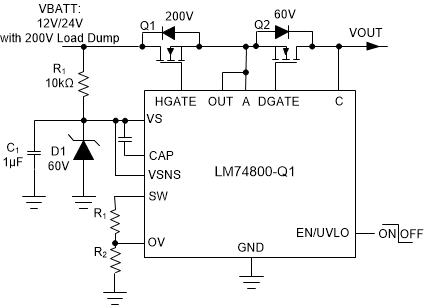ZHCSL09C April 2020 – December 2020 LM7480-Q1
PRODUCTION DATA
- 1 特性
- 2 应用
- 3 说明
- 4 Revision History
- 5 Device Comparison Table
- 6 Pin Configuration and Functions
- 7 Specifications
- 8 Parameter Measurement Information
- 9 Detailed Description
-
10Applications and Implementation
- 10.1 Application Information
- 10.2 Typical 12-V Reverse Battery Protection Application
- 10.3 200-V Unsuppressed Load Dump Protection Application
- 10.4 Do's and Don'ts
- 11Power Supply Recommendations
- 12Layout
- 13Device and Documentation Support
- 14Mechanical, Packaging, and Orderable Information
9.5.2 Ideal Diode with Unsuppressed Load Dump Protection
An extended overvoltage protection support above 65 V can be achieved by configuring the device with external back to back MOSFETs in common source topology as shown in Figure 9-6. Place a resistor R1 and a zener clamp across VS pin to GND to limit the voltage below 65 V. The load gets protected from overvoltages transients like un-suppressed load dumps with the help of overvoltage protection feature. Use R2 and R3 for setting the overvoltage protection threshold. When voltage at OV pin exceeds the set OV threshold then the HGATE turns OFF. This results in power path disconnection between input and output.
 Figure 9-6 Ideal Diode with 200-V
Unsupressed Load Dump Protection
Figure 9-6 Ideal Diode with 200-V
Unsupressed Load Dump Protection